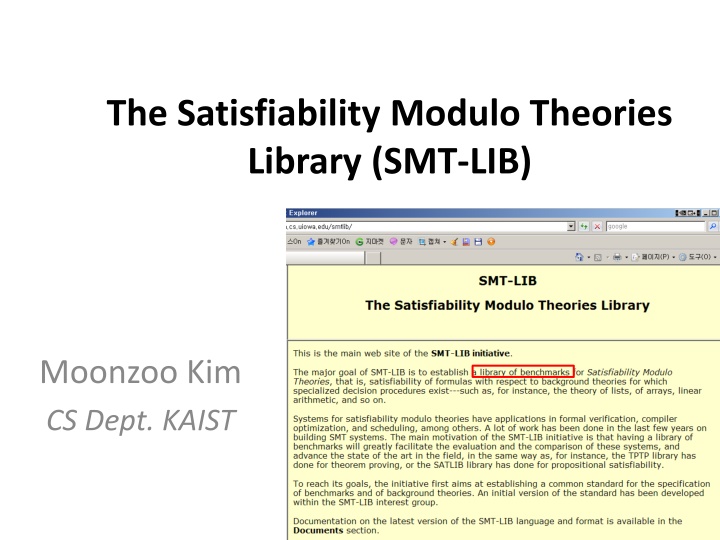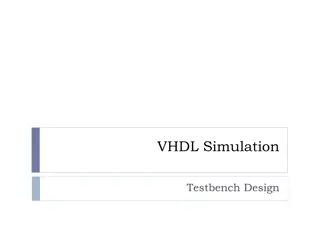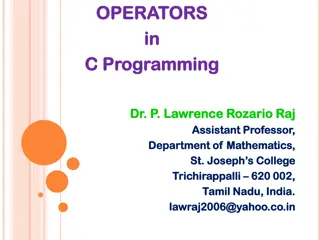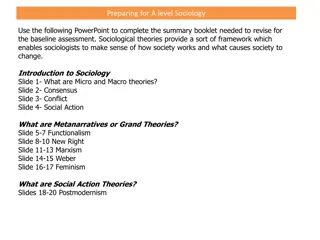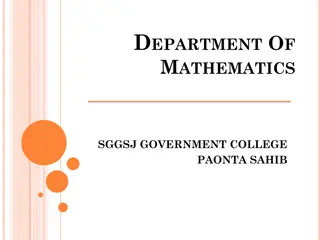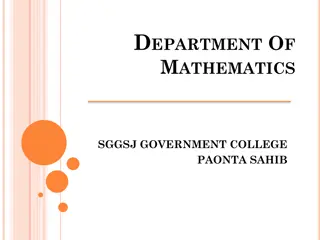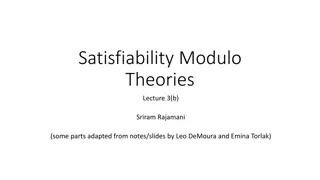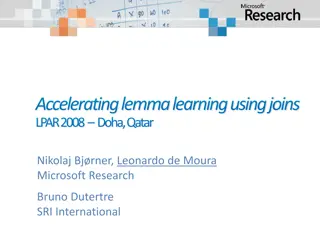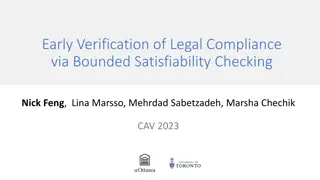SMT-LIB: The Satisfiability Modulo Theories Library Overview
The Satisfiability Modulo Theories Library (SMT-LIB) is a comprehensive tool for formal reasoning in various supported theories such as arrays, bit vectors, and integer and real arithmetic. It provides a wide range of supported sublogics for precise specifications and verifications. Moonzoo Kim, from KAIST, has contributed significantly to the development of this powerful tool. The Theory of Arrays within SMT-LIB, as written by Silvio Ranise and Cesare Tinelli, defines functional arrays with essential axioms and predefined functions. This theoretical framework enables logical equivalence between key elements. Explore this rich resource for advanced research and software verification.
Download Presentation

Please find below an Image/Link to download the presentation.
The content on the website is provided AS IS for your information and personal use only. It may not be sold, licensed, or shared on other websites without obtaining consent from the author.If you encounter any issues during the download, it is possible that the publisher has removed the file from their server.
You are allowed to download the files provided on this website for personal or commercial use, subject to the condition that they are used lawfully. All files are the property of their respective owners.
The content on the website is provided AS IS for your information and personal use only. It may not be sold, licensed, or shared on other websites without obtaining consent from the author.
E N D
Presentation Transcript
The Satisfiability Modulo Theories Library (SMT-LIB) Moonzoo Kim CS Dept. KAIST
Supported Theories (SMT-Lib v2) ArraysEx Functional arrays with extensionality. Fixed_Size_BitVectors Bit vectors with arbitrary size. Core Core theory, defining the basic Boolean operators Ints Integer numbers. Reals Real numbers. Reals_Ints Real and integer numbers. Moonzoo Kim Provable SW Lab 2/14
Supported Sublogics AUFLIA: Closed formulas over the theory of linear integer arithmetic and arrays extended with free sort and function symbols but restricted to arrays with integer indices and values. AUFLIRA: Closed linear formulas with free sort and function symbols over one- and two-dimentional arrays of integer index and real value. AUFNIRA: Closed formulas with free function and predicate symbols over a theory of arrays of arrays of integer index and real value. LRA: Closed linear formulas in linear real arithmetic. QF_ABV: Closed quantifier-free formulas over the theory of bitvectors and bitvector arrays. QF_AUFBV: Closed quantifier-free formulas over the theory of bitvectors and bitvector arrays extended with free sort and function symbols. QF_AUFLIA: Closed quantifier-free linear formulas over the theory of integer arrays extended with free sort and function symbols. QF_AX: Closed quantifier-free formulas over the theory of arrays with extensionality. QF_BV: Closed quantifier-free formulas over the theory of fixed-size bitvectors. QF_IDL: Difference Logic over the integers. In essence, Boolean combinations of inequations of the form x - y < b where x and y are integer variables and b is an integer constant. QF_LIA: Unquantifiedlinear integer arithmetic. In essence, Boolean combinations of inequations between linear polynomials over integer variables. QF_LRA: Unquantifiedlinear real arithmetic. In essence, Boolean combinations of inequations between linear polynomials over real variables. QF_NIA: Quantifier-free integer arithmetic. QF_NRA: Quantifier-free real arithmetic. QF_RDL: Difference Logic over the reals. In essence, Boolean combinations of inequations of the form x - y < b where x and y are real variables and b is a rational constant. QF_UF: Unquantifiedformulas built over a signature of uninterpreted (i.e., free) sort and function symbols. QF_UFBV: Unquantifiedformulas over bitvectors with uninterpreted sort function and symbols. QF_UFIDL: Difference Logic over the integers (in essence) but with uninterpretedsort and function symbols. QF_UFLIA: Unquantified linear integer arithmetic with uninterpreted sort and function symbols. QF_UFLRA: Unquantified linear real arithmetic with uninterpreted sort and function symbols. QF_UFNRA: Unquantified non-linear real arithmetic with uninterpreted sort and function symbols. UFLRA: Non-linear real arithmetic with uninterpretedsort and function symbols. UFNIA: Non-linear integer arithmetic with uninterpretedsort and function symbols. Moonzoo Kim Provable SW Lab
Theory of Arrays (theory Arrays :written_by {Silvio Ranise and Cesare Tinelli} :date {08/04/05} :sorts (Index Element Array) :funs ((select Array Index Element) (store Array Index Element Array)) :notes "It is not difficult to prove that the two axioms above are logically equivalent to the following \"McCarthy axiom\": Predefined data types Predefined f unctions (forall (?a Array) (?i Index) (?j Index) (?e Element) (= (select (store ?a ?i ?e) ?j) (ite (= ?i ?j) ?e (select ?a ?j)))) If-then-else term construct :definition "This is a theory of functional arrays without extensionality. It is formally and completely defined by the axioms below. " Such an axiom appeared in the following paper: Correctness of a Compiler for Arithmetic Expressions, by John McCarthy and James Painter, available at http://www-formal.stanford. edu/jmc/mcpain.html. " ) Bounded variables :axioms ( (forall (?a Array) (?i Index) (?e Element) (= (select (store ?a ?i ?e) ?i) ?e)) (forall (?a Array) (?i Index) (?j Index) (?e Element) (or (= ?i ?j) (= (select (store ?a ?i ?e) ?j) (select ?a ?j)))) ) Prefix operator Moonzoo Kim Provable SW Lab 4/14
Theory of Arrays w/ Extensionability :axioms ( (forall (?a Array) (?i Index) (?e Element) (= (select (store ?a ?i ?e) ?i) ?e)) (forall (?a Array) (?i Index) (?j Index) (?e Element) (or (= ?i ?j) (= (select (store ?a ?i ?e) ?j) (select ?a ?j)))) (theory ArraysEx :written_by {Silvio Ranise and Cesare Tinelli} :date {08/04/05} :updated {28/10/05} :history { Bug fix in the third axiom, pointed out by Robert Nieuwenhuis: The scope of 'forall (?i Index)' was the whole implication instead of just the premise of the implication. } :sorts (Index Element Array) :funs ((select Array Index Element) (store Array Index Element Array)) :definition "This is a theory of functional arrays with extensionality. It is formally and completely defined by the axioms below. (forall (?a Array) (?b Array) (implies (forall (?i Index) (= (select ?a ?i) (select ?b ?i))) (= ?a ?b))) ) :notes "This theory extends the theory Arrays with an axiom stating that any two arrays with the same elements are in fact the same array. " ) Moonzoo Kim Provable SW Lab 5/14
Theory of Integer (theory Ints :sorts (Int) :notes "The (unsupported) annotations of the function/pre dicate symbols have the following meaning: attribute | possible value | meaning ------------------------------------------------------- :assoc // the symbol is associative :comm // the symbol is commutative :unit a constant :trans // the symbol is transitive :refl // the symbol is reflexive :irref // the symbol is irreflexive :antisym // the symbol is antisymmetric " :funs ((0 Int) (1 Int) (~ Int Int) ; unary minus (- Int Int Int) ; binary minus (+ Int Int Int :assoc :comm :unit {0}) (* Int Int Int :assoc :comm :unit {1}) ) :preds ((<= Int Int :refl :trans :antisym) (< Int Int :trans :irref) (>= Int Int :refl :trans :antisym) (> Int Int :trans :irref) ) :definition "This is the first-order theory of the integers, that is , the set of all the first-order sentences over the given signature that are true in the structure of the integer numbers interpreting the signature's symbols in the obvious way (with ~ denoting the negation and - the subtraction functions). " :notes "Note that this theory is not (recursively) axiomatizable in a first-order logic such as SMT-LIB's underlying logic. That is why the theory is defined semantically. " ) Moonzoo Kim Provable SW Lab
Example of QF_LIA Benchmark (benchmark example :status sat :logic QF_LIA :extrafuns ((x1 Int) (x2 Int) (x3 Int) (x4 Int) (x5 Int)) ;human readable form ; x1-1 => x2 /\ ; x1-3 <= x2 /\ ; x1 = 2 x3+x5 /\ ; x3 = x5 /\ ; x2 = 6 x4 :formula (and (>= (- x1 x2) 1) (<= (- x1 x2) 3) (= x1 (+ (* 2 x3) x5)) (= x3 x5) (= x2 (* 6 x4)))) Expected output (optional) x2 Theory User defined variables Comments x1 -1 -3 Target formula (x1,x2)=(-3,-6) (x3,x4,x5)=(-1,-1,-1) Moonzoo Kim Provable SW Lab 7/14
Example of QF_UF Benchmark (benchmark example2-1 :logic QF_UF :extrasorts (A B C D) :extrafuns ((x A)(y B)(w A)(z C)(u D)) :extrafuns ((f A A B) (g A B B) (h1 B A B) (h2 B B B)) A model for the formula x-> v0 y->v1 w->v4 g->{ (v1,v0)->v2, else-> v2} f->{(v0,v0)->v3, (v0,v4)->v5, else->v5} h2->{(v1,v1)->v3, else -> v3} User defined data types User defined functions ;human readable form ; g(x,y) = h1(y,x) /\ ; f(x,x) = h2(y,y) /\ ; f(x,x) != f(x,w) :assumption((= (g x y) (h1 y x))) :assumption((= (f x x) (h2 y y)) :assumption((not (= (f x x) (f x w)))) :formula true ) 8/14
Another Example of QF_UF Benchmark (benchmark Quiz2 :logic QF_UF :extrasorts (A B C) :extrafuns ((a A) (b A) (c A)) :extrafuns ((f A B) (g B A C)) ;human readable form ; a=b/\ b=c -> g(f(a),b) = g(f(c),a) :formula (implies (and (= a b) (= b c)) (= (g ( f a) b) (g (f c) a))))) 3. Prove that F : a=b ^ b=c -> g(f(a), b) = g(f (c), a) is TEUF satisfiable 4. Prove F : a=b ^ b=c -> g(f(a), b) = g(f (c), a) is TEUF valid through proof tree A model for the formula a->v0 b->v1 c->v2 f->{v0->v3,v2->v5,else->v5} g->{(v3,v1)->v4,(v5,v0)->v6,else->v6} Then, how to check TEUF validity of F by using a SMT solver??? 9/14
Example of QF_AUFLIA (benchmark sort :logic QF_AUFLIA :extrafuns ((data_7 Array)) ; initial data[] declaration :extrafuns ((tmp_0 Int)) :extrafuns ((i_9 Int)) :assumption (= i_9 0) ; i=0; :extrafuns ((j_1 Int)) :assumption (= j_1 1) ; j=1; :extrafuns ((tmp_1 Int)) :assumption (= tmp_1 (select data_7 0)) ; tmp = data[0] :extrafuns ((data_8 Array)) :assumption (= data_8 (store data_7 0 (select data_7 1))); data[0]=data[1]; :extrafuns ((data_9 Array)) :assumption (= data_9 (store data_8 1 tmp_1)) ; data[1] = tmp; :extrafuns ((data_10 Array)) ; if (data[0] > data[1]) { tmp=data[0]; data[0]=data[1]; data[1]=tmp} :assumption (= data_10 (if_then_else (> (select data_7 0) (select data_7 1) ) data_9 data_7)) :formula (not (and (<= (select data_70 0) (select data_70 1)) (<= (select data_70 1) (select data_70 2)) ) #define N 7 int main(){ int data[N], i, j, tmp; for (i=0; i<N-1; i++) for (j=i+1; j<N; j++) if(data[i]>data[j]){ tmp = data[i]; data[i] = data[j]; data[j] = tmp; } assert(data[0]<=data[1]&& ); } Moonzoo Kim Provable SW Lab 10/14
Theory of Fixed_Size_BitVectors[32] :sorts_description "All sort symbols of the form BitVec[i], where i is a numeral between 1 and 32, inclusive. :funs_description "All function symbols with arity of the form (concatBitVec[i] BitVec[j] BitVec[m]) where - i,j,m are numerals - i,j > 0 - i + j = m <= 32 :funs_description "All function symbols with arity of the form (extract[i:j]BitVec[m] BitVec[n]) where - i,j,m,n are numerals - 32 >= m > i >= j >= 0, - n = i-j+1. :funs_description "All function symbols with arity of the form (op1 BitVec[m] BitVec[m]) or (op2 BitVec[m] BitVec[m] BitVec[m]) where - op1 is from {bvnot, bvneg} - op2 is from {bvand,bvor,bvxor,bvsub,bvadd,bvmul} - m is a numeral - 0 < m <= 32 :preds_description "All predicate symbols with arity of the form (pred BitVec[m] BitVec[m]) where - pred is from {bvlt, bvleq, bvgeq, bvgt} - m is a numeral - 0 < m <= 32 " - Variables If v is a variable of sort BitVec[m] with 0 < m <= 32, then [[v]] is some element of [{0,...,m-1} -> {0,1}], the set of total functions from {0,...,m-1} to {0,1}. - Constant symbols bv0 and bv1 of sort BitVec[32] [[bv0]] := \lambda x : [0...32). 0 [[bv1]] := \lambda x : [0...32). if x = 0 then 1 else 0 - Function symbols for concatenation [[(concat s t)]] := \lambda x : [0...n+m). if (x<m) then [[t]](x) else [[s]](x-m) where s and t are terms of sort BitVec[n] and BitVec[m], respectively, 0 < n <= 32, 0 < m <= 32, and n+m <= 32. - Function symbols for extraction [[(extract[i:j] s)]] := \lambda x : [0...i-j+1). [[s]](j+x) where s is of sort BitVec[l], 0 <= j <= i < l <= 32. - Function symbols for arithmetic operations To define the semantics of the bitvectoroperators bvadd , bvsub, bvneg, and bvmul, it is helpful to use these ancillary functions: o bv2nat which takes a bitvectorb: [0...m) --> {0,1} with 0 < m <= 32, and returns an integer in the range [0...2^m), and is defined as follows: bv2nat(b) := b(m-1)*2^{m-1} + b(m-2)*2^{m-2} + ... + b(0)*2^0 o nat2bv[m], with 0 < m <= 32, which takes a non-negative integer n and returns the (unique) bitvectorb: [0,...,m) -> {0,1} such that b(m-1)*2^{m-1} + ... + b(0)*2^0 = n MOD 2^m where MOD is usual modulo operation. [[(bvadd s t)]] := nat2bv[m](bv2nat(s) + bv2nat(t)) Moonzoo Kim Provable SW Lab
SMTLIB Benchmark Syntax Reserved keywords =, and, benchmark, distinct, exists, false, flet, forall, if then el se, iff, implies,ite, let, logic, not, or, sat, theory, true, unknow n, unsat, xor 12/10
Performance Comparison of SMT Solvers Q Quoted from SMT-Based Bounded Model Checking for Embedded ANSI-C Software by L.Cordeiro, et al ASE 2009 Moonzoo Kim Provable SW Lab 13/14
Performance Comparison between CBMC and SMT-CBMC Moonzoo Kim Provable SW Lab 14/14
